belt CITROEN DS4 2023 Owners Manual
[x] Cancel search | Manufacturer: CITROEN, Model Year: 2023, Model line: DS4, Model: CITROEN DS4 2023Pages: 296, PDF Size: 9.91 MB
Page 4 of 296

2
01
02
0304
05
10 Instrument panels
12
R
ev counter
13
W
arning and indicator lamps
27
E
lectric parking brake
30
I
ndicators
37
M
onochrome screen C
40
T
ouch screen
41
T
rip computer
45
D
ate and time adjustment
47
R
emote control key
50
K
eyless Entry and Starting
57
Alarm
59
Doors
60
Boot
61
E
lectric windows 64
F
ront seats
69
R
ear seats
70
S
teering wheel adjustment
70
M
irrors
72
M
anual air conditioning
74 D ual-zone automatic air conditioning
78 R ecommendations for ventilation and air
conditioning
79
F
ront demist – defrost
79
R
ear screen demist – defrost
80
P
anoramic windscreen
81 Front
fittings
83
C
ourtesy lamps
84
I
nterior mood lighting
84
C
entre consoles
85
Fr
ont armrest
87
St
orage drawers
88 Rear
fi
ttings
88 Boot
fittings92
L
ighting controls
94
D
irection indicators
95
A
utomatic illumination of headlamps
96
H
eadlamp adjustment
97
D
irectional lighting
97 C ornering lighting
99
W
iper control stalk
103
G
eneral safety recommendations
104
H
azard warning lamps
104
Horn
104
E
mergency or assistance call
108
E
lectronic stability control (ESC)
110
Se
at belts
113
Airbags
116
Ch
ild seats
118
D
eactivating the passenger's front airbag
124
I
SOFIX mountings and child seats
129
M
anual child lock
130
E
lectric child lock
Over view
Instruments
Access Ease of use and comfort
Safety Lighting and visibility
Eco-driving
7 4
4 Instruments and controls
Contents
Page 16 of 296
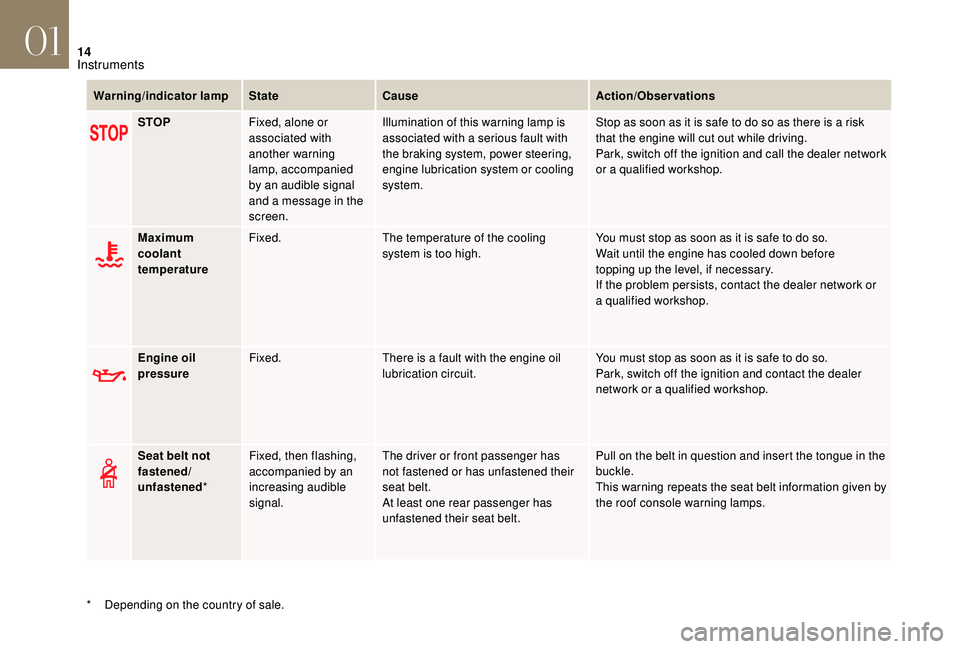
14
Warning/indicator lampStateCause Action/Observations
STOP Fixed, alone or
associated with
another warning
lamp, accompanied
by an audible signal
and a message in the
screen. Illumination of this warning lamp is
associated with a serious fault with
the braking system, power steering,
engine lubrication system or cooling
system.
Stop as soon as it is safe to do so as there is a risk
that the engine will cut out while driving.
Park, switch off the ignition and call the dealer network
or a qualified workshop.
Maximum
coolant
temperature Fixed.
The temperature of the cooling
system is too high. You must stop as soon as it is safe to do so.
Wait until the engine has cooled down before
topping up the level, if necessary.
If the problem persists, contact the dealer network or
a
qualified workshop.
Engine oil
pressure Fixed.
There is a fault with the engine oil
lubrication circuit. You must stop as soon as it is safe to do so.
Park, switch off the ignition and contact the dealer
network or a qualified workshop.
Seat belt not
fastened/
unfastened *Fixed, then flashing,
accompanied by an
increasing audible
signal. The driver or front passenger has
not fastened or has unfastened their
seat belt.
At least one rear passenger has
unfastened their seat belt. Pull on the belt in question and insert the tongue in the
buckle.
This warning repeats the seat belt information given by
the roof console warning lamps.
*
D
epending on the country of sale.
01
Instruments
Page 17 of 296
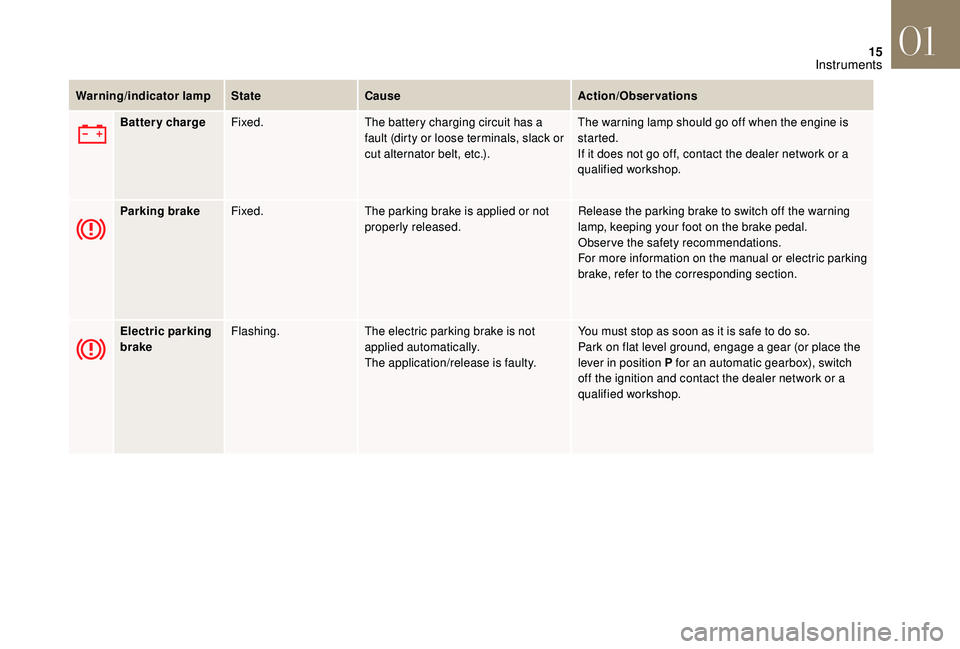
15
Warning/indicator lampStateCause Action/Observations
Battery charge Fixed. The battery charging circuit has a
fault (dirty or loose terminals, slack or
cut alternator belt, etc.). The warning lamp should go off when the engine is
started.
If it does not go off, contact the dealer network or a
qualified workshop.
Parking brake Fixed. The parking brake is applied or not
properly released. Release the parking brake to switch off the warning
lamp, keeping your foot on the brake pedal.
Observe the safety recommendations.
For more information on the manual or electric parking
brake, refer to the corresponding section.
Electric parking
brake Flashing.
The electric parking brake is not
applied automatically.
The application/release is faulty. You must stop as soon as it is safe to do so.
Park on flat level ground, engage a gear (or place the
lever in position P for an automatic gearbox), switch
off the ignition and contact the dealer network or a
qualified workshop.
01
Instruments
Page 21 of 296
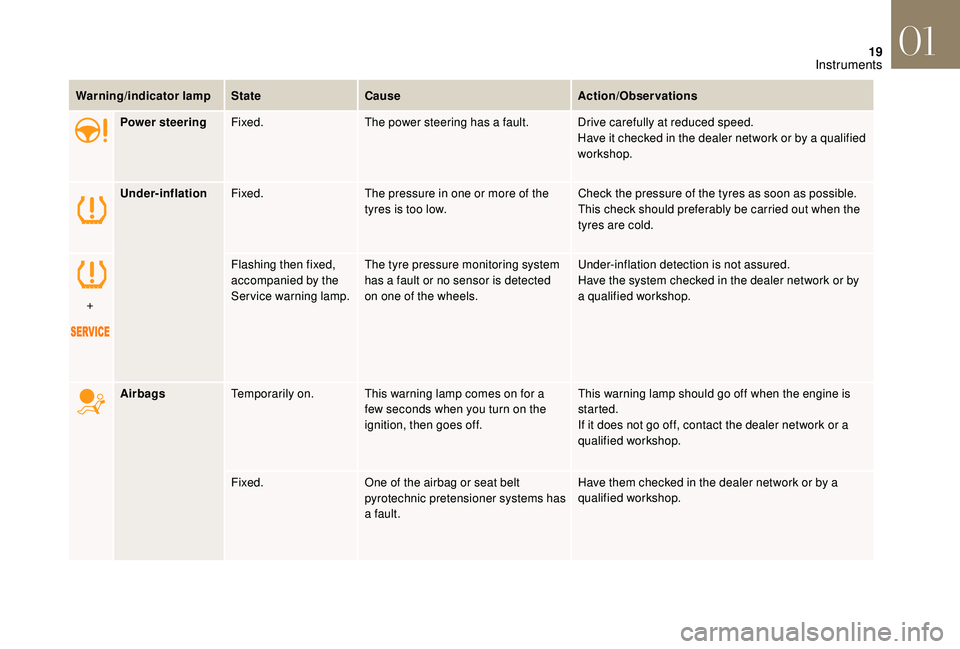
19
Warning/indicator lampStateCause Action/Observations
Power steering Fixed. The power steering has a fault. Drive carefully at reduced speed.
Have it checked in the dealer network or by a qualified
workshop.
Under-inflation Fixed. The pressure in one or more of the
tyres is too low. Check the pressure of the tyres as soon as possible.
This check should preferably be carried out when the
tyres are cold.
+ Flashing then fixed,
accompanied by the
Service warning lamp.
The tyre pressure monitoring system
has a fault or no sensor is detected
on one of the wheels. Under-inflation detection is not assured.
Have the system checked in the dealer network or by
a
qualified workshop.
Airbags Temporarily on. This warning lamp comes on for a
few seconds when you turn on the
ignition, then goes off. This warning lamp should go off when the engine is
started.
If it does not go off, contact the dealer network or a
qualified workshop.
Fixed. One of the airbag or seat belt
pyrotechnic pretensioner systems has
a fault. Have them checked in the dealer network or by a
qualified workshop.
01
Instruments
Page 24 of 296
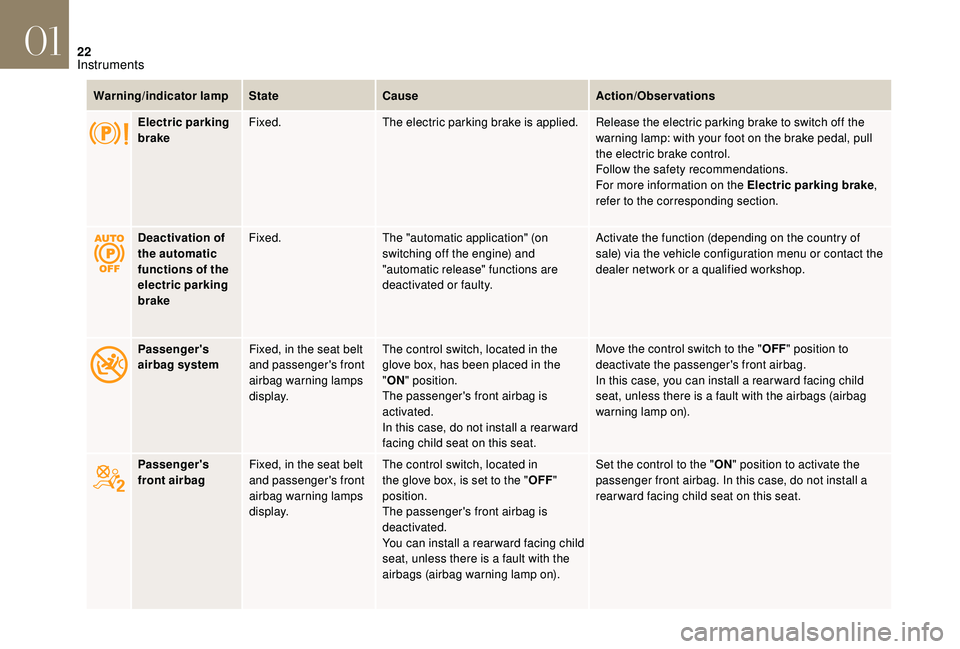
22
Warning/indicator lampStateCause Action/Observations
Electric parking
brake Fixed.
The electric parking brake is applied. Release the electric parking brake to switch off the
warning lamp: with your foot on the brake pedal, pull
the electric brake control.
Follow the safety recommendations.
For more information on the Electric parking brake ,
refer to the corresponding section.
Deactivation of
the automatic
functions of the
electric parking
brake Fixed.
The "automatic application" (on
switching off the engine) and
"automatic release" functions are
deactivated or faulty. Activate the function (depending on the country of
sale) via the vehicle configuration menu or contact the
dealer network or a qualified workshop.
Passenger's
airbag system Fixed, in the seat belt
and passenger's front
airbag warning lamps
display. The control switch, located in the
glove box, has been placed in the
"
ON " position.
The passenger's front airbag is
activated.
In this case, do not install a rear ward
facing child seat on this seat. Move the control switch to the "
OFF" position to
deactivate the passenger's front airbag.
In this case, you can install a rear ward facing child
seat, unless there is a fault with the airbags (airbag
warning lamp on).
Passenger's
front airbag Fixed, in the seat belt
and passenger's front
airbag warning lamps
display. The control switch, located in
the glove box, is set to the "
OFF"
position.
The passenger's front airbag is
deactivated.
You can install a rear ward facing child
seat, unless there is a fault with the
airbags (airbag warning lamp on). Set the control to the "
ON" position to activate the
passenger front airbag. In this case, do not install a
rear ward facing child seat on this seat.
01
Instruments
Page 71 of 296

69
Rear seats
Bench seat with fixed one-piece cushion and
split backrest (2/3 – 1/3) which can be folded
individually to adapt the load space in the boot.
Rear head restraints
These have one position for use (up) and a
stowed position (down).
They can also be removed.
To remove a head restraint:
F
r
elease the backrest using the control 1 ,
F
t
ilt the backrest 2 slightly forwards,
Folding the backrest
F Move the corresponding front seat for wards if necessary.
F
p
ull the head restraint upwards to the stop,
F
t
hen, press the lug A .
Never drive with the head restraints
removed; they must be fitted and correctly
adjusted. F
P
lace the head restraints in the low position.
F
P
osition the seat belt between the outer and
centre head restraints to avoid trapping the
belt when repositioning the seat backrest.
F
P
ull control 1 for wards to release the seat
backrest 2 .
Returning the backrest to the normal position
F Put the seat backrest in the upright position
and lock it in place.
F
C
heck that the red indicator, located next to
the seat control, is no longer visible.
F
P
ut the seat belt back in place on the side of
the seat backrest.
When repositioning the seat backrest,
take care not to trap the seat belts.
F
F
old the seat backrest 2 on to the cushion.
03
Ease of use and comfort
Page 112 of 296

11 0
ASR/DSC
These systems offer increased safety
in normal driving, but they should not
encourage the driver to take extra risks or
drive at high speed.
It is in conditions of reduced grip (rain,
snow, ice) that the risk of loss of grip
increases. It is therefore important for your
safety to keep these systems activated in
all conditions, and particularly in difficult
conditions.
The correct operation of these systems
depends on observation of the
manufacturer's recommendations, not
only about the wheels (tyres and rims),
braking and electronic components but
also the assembly and repair procedures
used in the dealer network.
To benefit in full from the effectiveness
of these systems in wintry conditions,
the vehicle must be fitted with four snow
tyres, allowing the vehicle to retain neutral
behaviour on the road.Seat belts
Front seat belts
The front seat belts are fitted with a
pretensioning and force limiting system.
This system improves safety in the front
seats in the event of a front or side impact.
Depending on the severity of the impact, the
pretensioning system instantly tightens the seat
belts against the body of the occupants.
The pretensioning seat belts are active when
the ignition is on.
The force limiter reduces the pressure of
the seat belt on the passenger’s chest, thus
improving their protection.
Fastening
F Pull the strap then insert the tongue in the buckle.
F
C
heck that the seat belt is fastened
correctly by pulling the strap.
Unfastening
F Press the red button on the buckle.
F G uide the seat belt as it reels in.
Height adjustment
F To lower the attachment point, squeeze the control A and slide it downwards.
F
T
o raise the attachment point, slide the
control A upwards.
Seat belt not fastened/unfastened
warning lamp in the instrument
panel
When the ignition is switched on, this
warning lamp comes on in the instrument
panel if the driver and/or the front
passenger have not fastened their seat belt.
Above approximately 12 mph (20 km/h),
this warning lamp flashes for two minutes
accompanied by an audible signal of increasing
volume. Once these two minutes have elapsed,
this warning lamp remains on until the driver
and/or the front passenger fasten their seat belt.
05
Safety
Page 113 of 296

111
Seat belt not fastened/unfastened
warning lamps display
1.Driver's seat belt not fastened/
unfastened warning lamp.
2. Front passenger's seat belt not fastened/
unfastened warning lamp.
If the seat belt is not fastened or is
unfastened, the corresponding warning lamp
1 or 2 illuminates in red on the seat belt and
passenger's front airbag warning lamps display,
accompanied by an audible signal and a
message in the screen.
Rear seat belts
The rear seats are each fitted with a three-point
seat belt and, for the outer seats, a force limiter.
Fastening
F Pull the strap then insert the tongue in the buckle.
F
C
heck that the seat belt is fastened
correctly by pulling the strap.
Unfastening
F Press the red button on the buckle.
F G uide the seat belt as it reels in.
F
O
n the outer seat belts, raise the bar to the
top of the backrest to prevent the tongue
from knocking against the side trim.
Seat belt unfastened warning lamp
in the instrument panel
This warning lamp comes on in the
instrument panel when one or more rear
passengers unfasten their seat belt.
Above approximately 12 mph (20 km/h),
this warning lamp flashes for two minutes
accompanied by an audible signal of increasing
volume. Once these two minutes have elapsed,
this warning lamp remains on until the one or
more rear passengers fasten their seat belt.
Seat belt unfastened warning lamps
display
3. Rear right seat belt warning lamp.
4. Rear centre seat belt warning lamp.
5. Rear left seat belt warning lamp.
When the ignition is switched on, with the engine
running or when the vehicle is moving at less
than about 12 mph (20 km/h), the corresponding
warning lamps 3 , 4 and 5 come on in red for
approximately 30 seconds, if the seat belt is not
fastened.
When the vehicle is moving at more than about
12 mph (20 km/h), the corresponding warning
lamps 3 , 4 or 5 come on in red, accompanied by
an audible signal and a message in the screen, if
a rear passenger has unfastened their seat belt.
05
Safety
Page 114 of 296
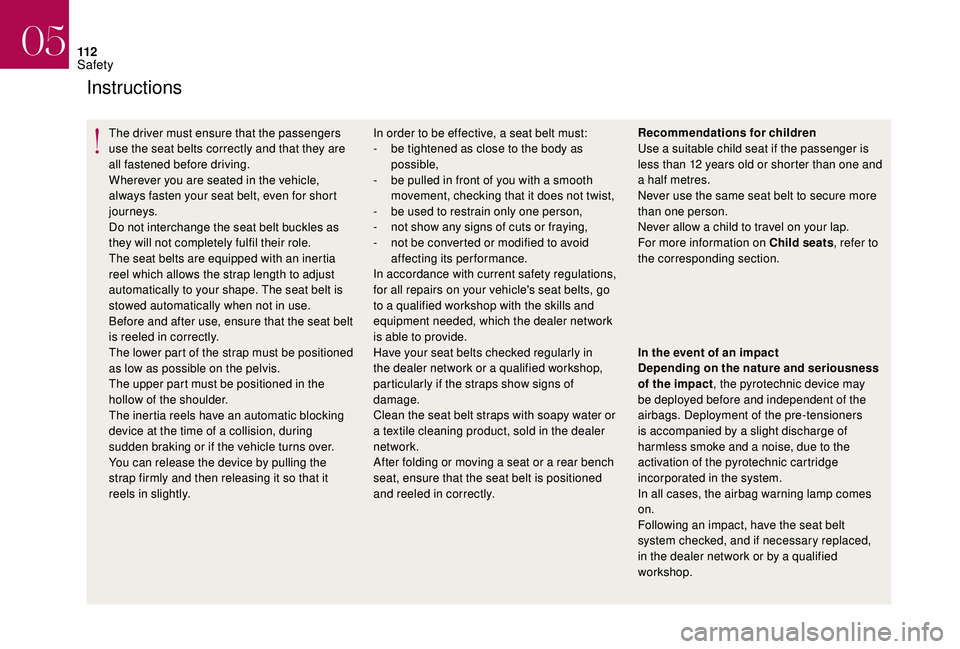
11 2
Instructions
The driver must ensure that the passengers
use the seat belts correctly and that they are
all fastened before driving.
Wherever you are seated in the vehicle,
always fasten your seat belt, even for short
journeys.
Do not interchange the seat belt buckles as
they will not completely fulfil their role.
The seat belts are equipped with an inertia
reel which allows the strap length to adjust
automatically to your shape. The seat belt is
stowed automatically when not in use.
Before and after use, ensure that the seat belt
is reeled in correctly.
The lower part of the strap must be positioned
as low as possible on the pelvis.
The upper part must be positioned in the
hollow of the shoulder.
The inertia reels have an automatic blocking
device at the time of a collision, during
sudden braking or if the vehicle turns over.
You can release the device by pulling the
strap firmly and then releasing it so that it
reels in slightly.In order to be effective, a seat belt must:
-
b e tightened as close to the body as
possible,
-
b
e pulled in front of you with a smooth
movement, checking that it does not twist,
-
b
e used to restrain only one person,
-
n
ot show any signs of cuts or fraying,
-
n
ot be converted or modified to avoid
affecting its performance.
In accordance with current safety regulations,
for all repairs on your vehicle's seat belts, go
to a qualified workshop with the skills and
equipment needed, which the dealer network
is able to provide.
Have your seat belts checked regularly in
the dealer network or a qualified workshop,
particularly if the straps show signs of
damage.
Clean the seat belt straps with soapy water or
a textile cleaning product, sold in the dealer
network.
After folding or moving a seat or a rear bench
seat, ensure that the seat belt is positioned
and reeled in correctly. Recommendations for children
Use a suitable child seat if the passenger is
less than 12 years old or shorter than one and
a half metres.
Never use the same seat belt to secure more
than one person.
Never allow a child to travel on your lap.
For more information on Child seats
, refer to
the corresponding section.
In the event of an impact
Depending on the nature and seriousness
of the impact , the pyrotechnic device may
be deployed before and independent of the
airbags. Deployment of the pre-tensioners
is accompanied by a slight discharge of
harmless smoke and a noise, due to the
activation of the pyrotechnic cartridge
incorporated in the system.
In all cases, the airbag warning lamp comes
on.
Following an impact, have the seat belt
system checked, and if necessary replaced,
in the dealer network or by a qualified
workshop.
05
Safety
Page 115 of 296

11 3
Airbags
General information
This system contributes towards improving
the safety of passengers (with the exception
of the rear centre passenger) in the event of
violent collisions. The airbags supplement the
action of the seat belts fitted with force limiters
(all
except the centre rear passenger belt).
If a collision occurs, the electronic detectors
record and analyse the front and side impacts
sustained in the impact detection zones:
-
i
n the event of a serious impact, the airbags
are deployed instantly and contribute
towards better protection of the passengers
(with the exception of the rear centre
passenger); immediately after the impact,
the airbags deflate rapidly so that they
do not hinder visibility or the exit of the
passengers,
-
i
n the case of a minor or rear impact or in
certain roll-over conditions, the airbags
may not be deployed; the seat belt
alone contributes towards ensuring your
protection in these situations.
The airbags do not operate when the
ignition is switched off.
This equipment will only deploy once. If a
second impact occurs (during the same or
a subsequent accident), the airbag will not
be deployed again.
Impact detection zones
A. Front impact zone.
B. Side impact zone.
The deployment of an airbag is
accompanied by a slight emission of
smoke and a noise, due to the detonation
of the pyrotechnic charge incorporated in
the system.
This smoke is not harmful, but sensitive
individuals may experience slight irritation.
The detonation noise associated with the
deployment of an airbag may result in a
slight loss of hearing for a short time.
Front airbags
Deployment
The airbags are deployed (except the passenger's
front airbag if it is deactivated) in the event of a
serious frontal impact to all or part of the frontal
impact zone A , in the longitudinal centreline of the
vehicle on a horizontal plane and directed from
the front to the rear of the vehicle.
The front airbag inflates between the thorax and
head of the front occupant of the vehicle and the
steering wheel, driver's side, or the dashboard,
passenger's side, to cushion their for ward
movement.
This system protects the driver and front
passenger in the event of a severe frontal
impact in order to limit the risk of injury to the
head and chest.
The driver's airbag is fitted in the centre of the
steering wheel; the front passenger's airbag is
fitted in the dashboard above the glove box.
05
Safety